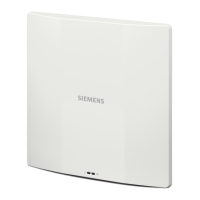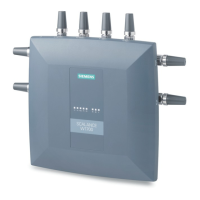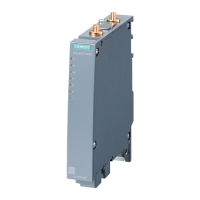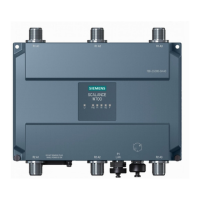Wireless Network Profiles
11.1 Configuring Wireless Network Profiles
SCALANCE W1750D UI
114 Configuration Manual, 02/2018, C79000-G8976-C451-02
Content filtering Select
to route all DNS requests for the non-
corporate domains to OpenDNS on this network.
Inactivity timeout Specify an interval for session timeout in seconds, minutes,
or hours. If a client session is inactive for the specified dura-
tion, the session expires and the user is required to log in
again. You can specify a value within the range of 60–86,400
seconds (24 hours) for a client session. The default value is
Deauth Inactive Clients Select
to allow the AP to send a deauthentication
frame to the inactive client and clear client entry.
SSID Select the
check box if you do not want the SSID (net-
work name) to be visible to users.
Select the
check box if you want to disable the SSID.
On selecting this, the SSID will be disabled, but will not be
removed from the network. By default, all SSIDs are enabled.
Out of service (OOS) Enable or disable the SSID based on the following OOS
states of the AP:
l VPN down
l Uplink down
l Internet down
l Primary uplink down
The network will be out of service when selected event oc-
curs and the SSID is enabled or disabled as per the configu-
ration settings applied. For example, if you select the VPN
down option from the drop-down list and set the status to
enabled, the SSID is enabled when the VPN connection is
down and is disabled when the VPN connection is restored.
OOS time (global) Configure a hold time interval in seconds within a range of
30–300 seconds, after which the out-of-service operation is
triggered. For example, if the VPN is down and the config-
ured hold time is 45 seconds, the effect of this out-of-service
state impacts the SSID availability after 45 seconds.
Max clients threshold Specify the maximum number of clients that can be config-
ured for each Basic Service Set Identifier (BSSID) on a
WLAN. You can specify a value within the range of 0–255.
SSID Encoding To encode the SSID, select UTF-8. By default, the SSIDs are
not encoded.
When a wireless SSID is encoded, by default, UTF-8
is added to the access rules that are active on the SSID.
However this does not apply for the access rules that are
configured separately for the SSID.
UTF-8 is not supported
Deny inter user bridging When enabled, the bridging traffic between two clients that
are connected to the same SSID on the same VLAN is disa-
bled. The clients can connect to the Internet, but cannot
communicate with each other, and the bridging traffic be-
tween the clients is sent to the upstream device to make the

